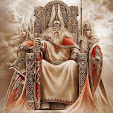Jacob (1785-1863) and Wilhelm (1786-1859) Grimm were German academics, philologists, cultural researchers, lexicographers and authors who together collected and published folklore during the 19th century. They were among the best-known storytellers of folk tales, and popularized stories such as "Cinderella", "The Frog Prince", "The Goose-Girl", "Hansel and Gretel", "Rapunzel", "Sleeping Beauty", and "Snow White". Their first collection of folk tales. Children's and Housefold Tales (Kinder und Hausmärchen), was published in 1812.

The brothers spent their formative years in the German town of Hanau. Their father's death in 1796 impoverished the family and affected the brothers for many years after. They attended the University of Marburg where they developed a curiosity about German folklore, which grew into a lifelong dedication to collecting German folk tales. The rise of Romanticism during the 19th century revived interest in traditional folk stories, which to the brothers represented a pure form of national literature and culture.

With the goal of researching a scholarly treatise on folk tales, they established a methodology for collecting and recording folk stories that became the basis for folklore studies. Between 1812 and 1857, their first collection was revised and republished many times, growing from 86 stories to more than 200. In addition to writing and modifying folk tales, the brothers wrote collections of well-respected German and Scandinavian mythologies, and in 1838 they began writing a definitive German dictionary (Deutsches Wörterbuch), which they were unable to finish during their lifetimes.

Many of the Grimm's folk tales have enjoyed enduring popularity. The tales are available in more than 100 languages and have been adapted by filmmakers including Lotte Reiniger and Walt Disney, with films such as Snow White and the Seven Dwarfs and Sleeping Beauty. During the 1930s and 40s, the tales were used as propaganda by the Third Reich: later in the 20th century psychologists such as Bruno Bettelheim reaffirmed the value of the work, in spite of the cruelty and violence in original versions of some of the tales, which the Grimms eventually sanitized.

The brothers were inspired by their law professor Friedrich von Savigny, who awakened in them an interest in history and philology, and they turned to studying medieval German lierature. They shared Savigny's desire to see unification of the 200 German principalities into a single state. Through Savigny and his circle of friends - German romantics such as Clemens Brentano and Ludwig Achim von Arnim - the Grimm were introduced to the ideas of Johann Gottfried Herder, who thought that German literature should revert to simpler forms, which he defined as Volkspoesie (natural poetry) as opposed to Kunstpoesie (artistic poetry).

The brothers dedicated themselves with great enthusiasm to their studies, about which Wilhelm wrote in his autobiography, "the ardor with which we studied Old German helped us overcome the spiritual depression of those days". Jacob was still financially responsible for his mother, brother, and younger siblings in 1805, so he accepted a post in Paris as research assistant to von Savigny. On his return to Marburg, he was forced to abandon his studies to support the family, whose poverty was so extreme that food was often scarce. He took a job with the Hessian War Commission. In a letter written to his aunt at this time, Wilhelm wrote of their circumstances, "we five people eat only three portions and only once a day".

Jacob found full-time employment in 1808 when he was appointed court librarian to the King of Westphalia and went on to become librarian in Kassel. After their mother's death that year, he became fully resonsible for his younger siblings. He arranged and paid for his brother Ludwig's studies at art school and for Wilhelm's extended visit to Halle to seek treatment for heart and respiratory ailments, following which Wilhelm joined Jacob as librarian in Kassel. The brothers also began collecting folk tales about this time, in a cursory manner and on Brentano's request. According to Jack Zipes, at this point "the Grimms were unable to devote all their energies to their research and did not have a clear idea about the significance of collecting folk tales in this initial phase".

During their employment as librarians - which paid little but afforded them ample time for research - the brothers experienced a productive period of scholarship, publishing a number of books between 1812 and 1830. In 1812, they published their first volume of 86 folk tales, Kinder und Hausmärchen, followed quickly by two volumes of German legends and a volume or early literary history. They went on to publish works about Danish and Irish folk tales and Norse mythology, while continuing to edit the German folk tale collection. These works became so widely recognized that the brothers received honorary doctorates from universities in Marburg, Berlin, and Breslau (now Wroclaw).



















































